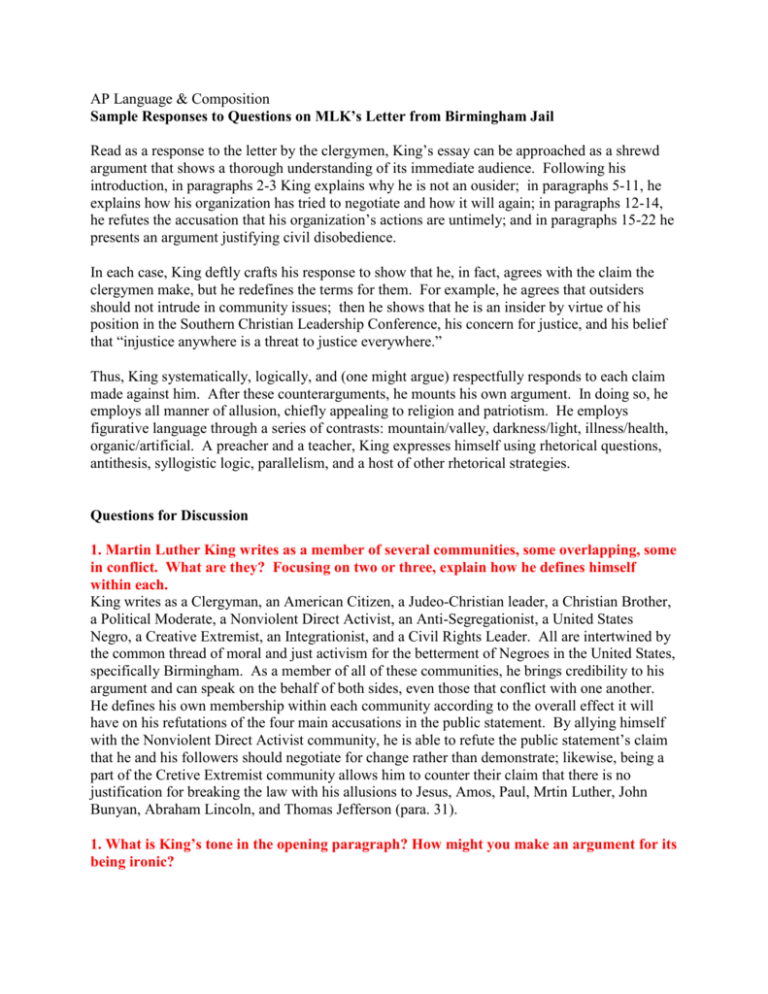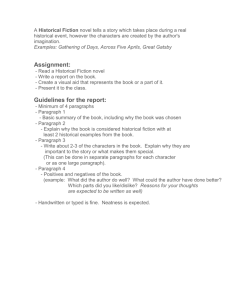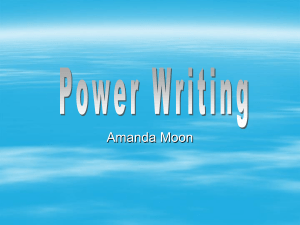AP Language & Composition Sample Responses to Questions on
advertisement

AP Language & Composition Sample Responses to Questions on MLK’s Letter from Birmingham Jail Read as a response to the letter by the clergymen, King’s essay can be approached as a shrewd argument that shows a thorough understanding of its immediate audience. Following his introduction, in paragraphs 2-3 King explains why he is not an ousider; in paragraphs 5-11, he explains how his organization has tried to negotiate and how it will again; in paragraphs 12-14, he refutes the accusation that his organization’s actions are untimely; and in paragraphs 15-22 he presents an argument justifying civil disobedience. In each case, King deftly crafts his response to show that he, in fact, agrees with the claim the clergymen make, but he redefines the terms for them. For example, he agrees that outsiders should not intrude in community issues; then he shows that he is an insider by virtue of his position in the Southern Christian Leadership Conference, his concern for justice, and his belief that “injustice anywhere is a threat to justice everywhere.” Thus, King systematically, logically, and (one might argue) respectfully responds to each claim made against him. After these counterarguments, he mounts his own argument. In doing so, he employs all manner of allusion, chiefly appealing to religion and patriotism. He employs figurative language through a series of contrasts: mountain/valley, darkness/light, illness/health, organic/artificial. A preacher and a teacher, King expresses himself using rhetorical questions, antithesis, syllogistic logic, parallelism, and a host of other rhetorical strategies. Questions for Discussion 1. Martin Luther King writes as a member of several communities, some overlapping, some in conflict. What are they? Focusing on two or three, explain how he defines himself within each. King writes as a Clergyman, an American Citizen, a Judeo-Christian leader, a Christian Brother, a Political Moderate, a Nonviolent Direct Activist, an Anti-Segregationist, a United States Negro, a Creative Extremist, an Integrationist, and a Civil Rights Leader. All are intertwined by the common thread of moral and just activism for the betterment of Negroes in the United States, specifically Birmingham. As a member of all of these communities, he brings credibility to his argument and can speak on the behalf of both sides, even those that conflict with one another. He defines his own membership within each community according to the overall effect it will have on his refutations of the four main accusations in the public statement. By allying himself with the Nonviolent Direct Activist community, he is able to refute the public statement’s claim that he and his followers should negotiate for change rather than demonstrate; likewise, being a part of the Cretive Extremist community allows him to counter their claim that there is no justification for breaking the law with his allusions to Jesus, Amos, Paul, Mrtin Luther, John Bunyan, Abraham Lincoln, and Thomas Jefferson (para. 31). 1. What is King’s tone in the opening paragraph? How might you make an argument for its being ironic? Consider that when King wrote “Letter,” he was not the icon he is today. He was well known, certainly, but he was not universally admired and, in fact, was under FBI investigation. Thus, to read the opening paragraph with the iconic King in mind is to see clear irony in the distance between the clergy and him. Putting it in context, however, the opening paragraph might be better read as respectful and courteous in tone. King clearly has a healthy sense of his own worth, pointing out that he usually does not answer criticism because it would preclude “constructive work” and that he has “secretaries” in the plural. Furthermore, he points out that since the clergy are “men of genuine good will,” he will respond in “patient and reasonable terms.” Since one is generally patient and reasonable with children or others not on one’s level, a case might be made for the tone being somewhat condescending. 2. Why does King arrange paragraphs 2–4 in the order that he does? How would reversing the order change the impact? In these paragraphs, King explains why he is not an outsider. First, he has a job to do; second, he is acting in the proper role of a minister, a man of God; third, he is acting as a patriot who is rightly concerned for injustice anywhere “inside the United States.” He moves from specific to abstract, starting with the specific details of his role in the Southern Christian Leadership Conference, moving to his broader role as a minister who lives according to Scripture (the first of many references to Paul), and finally emphasizing his commitment to justice in the abstract since, as he says, “we are caught in an inescapable network of mutuality.” 3. How do King’s allusions to biblical figures and events appeal to both ethos and pathos? Any reference to religion has some appeal to pathos, so when King refers to scriptural texts or figures from the Bible, he is bound to evoke an emotional response. In this case, his audience is other members of the clergy, Christian and Jewish, so his familiarity with Old and New Testament figures and events attests to his knowledge and understanding of texts that are sacred to all members of that religious community. 4. Why does King go into such detail to explain the basic principles and process of the nonviolent protest movement? In their letter, the clergy have indicated that protests, including any acts of civil disobedience, can result in violence and ultimately anarchy. King takes several paragraphs to explain in a systematic, logical way the methods of a nonviolent campaign. In paragraph 6, for example, he sets out the “four basic steps”—each thoughtful and disciplined. In subsequent paragraphs, he explains the political climate of Birmingham and how he and his community have been mindful of the individuals (he names several) and events (such as the mayoral election) in that community. His detailed and cerebral explanation of philosophy and method implies that the nonviolent campaign is the antithesis of protests that act precipitously without regard for the consequences. Form follows function in this case: the orderly explanation reflects the orderly process being explained. 5. In sentence 2 of paragraph 14, what is the effect of juxtaposing the rate of change in Asian and African cultures with the rate of change in American culture? King may have had several purposes for this juxtaposition, expressed through a vivid metaphor of “horse-and-buggy pace” with “jet-like speed.” For one, he appeals to the patriotic spirit of Americans who would not want their country to lag behind any others in any category, including social justice. Second, this juxtaposition alludes to the worldwide changes as people of color in the Caribbean, Asia, and Africa are demanding and winning independence from Western powers. It also suggests the inevitability and justice of such change. Finally, the juxtaposition implies a partnership outside the United States that strengthens the struggle here and can be read as a veiled reminder that some of these independence movements have not been peaceful. 6. In the long sentence in paragraph 14 (beginning with “But when you have seen”), why does King arrange the “when” clauses in the order that he does? Try repositioning them, and then discuss the difference in effect. This periodic sentence is the quintessential example of form merging with content. King emphasizes time and urgency by the repetition of “when” and the accumulation of clauses enumerating the injustices African Americans have endured. One way to look at the structure is that King begins with more general situations (“twenty million Negro brothers smothering in an airtight cage of poverty”), moves toward more personal ones that involve “your six-year-olddaughter” and “your wife and mother,” and ends back with a larger sense of the identity of a people who are “harried by day and haunted by night.” Overall, King uses vivid detail to paint what are essentially a series of vignettes in these subordinate clauses. 7. What rhetorical strategies are used in paragraph 25? Identify at least four. King asks a series of rhetorical questions crafted with a parallel sentence structure and repetition of “Isn’t.” He alludes to Socrates and biblical events. In each of the rhetorical questions, he draws an analogy. He repeats the word “precipitate,” in two cases “precipitate violence,” to emphasize his cause and effect argument. His final sentence is an example of antithesis 8. What are the chief rhetorical strategies used in paragraph 31? Identify at least five. King uses several rhetorical strategies to point out the irony in using the term “extremist” as a pejorative. He asks a series of rhetorical questions that use a parallel structure of an interrogative followed by a quotation that implies an answer. He cites the authority of biblical figures, a theologian, a literary figure, and patriots. He repeats the word “extremists” so often that it becomes as ordinary as he is claiming it is. The final sentence is an understatement, which emphasizes the irony. 9. Why does King wait until paragraph 45 to address the alleged commendable behavior of the Birmingham police in “preventing violence”? In the opening paragraphs, King addresses four of the criticisms the clergy leveled at him, and in each case he shows that, in fact, he agrees with their point; they have simply misunderstood. For example, he says that he agrees negotiation is preferable to demonstration; his group tried to negotiate but failed; thus, they are demonstrating in order to gain the equal power that is necessary for successful negotiation. The one criticism that he cannot agree with is that the Birmingham police have done a commendable job. King firmly and completely says the clergy are wrong. If he had taken them on, so to speak, at the outset, he would have jeopardized his “patient and reasonable” approach and risked losing his audience by seeming confrontational. By the end of the letter, he has had his say and is in a stronger position to take the clergy to task. 10. Trace one of the following patterns of figurative language throughout King’s letter: darkness and light, high and low, sickness and health. The light and dark/high and low imagery occurs in biblical images of mountain and valley, sunshine and clouds. A few passages to consider include: • Paragraph 10: “dark depths of prejudice . . . majestic heights of understanding” • Paragraph 14: “abyss of despair” • Paragraph 24: “like a boil that can never be cured so long as it is covered up but must be opened with all its ugliness to the natural medicines of air and light . . .” • Paragraph 27: “the quicksand of racial injustice to the solid rock of human dignity” • Paragraph 32: “the disease of segregation” • Paragraph 43: “the dark mountain of disappointment” • Paragraph 47: “those great wells of democracy” • Paragraph 50: “dark clouds of racial prejudice . . . deep fog . . . radiant stars” 11. King uses repetition of single words or phrases, of sentence structures, and of sounds. Focusing on a passage of one or more paragraphs, discuss the effect of this use of repetition. Several paragraphs that illustrate repetition have already been discussed: 14, 25, 31. Another good example is paragraph 44, where King repeats the structure of a complex sentence beginning with an “if” clause and the phrase “I have no. . . .” He also repeats the conjunction “Before” in two sentences. Consider the oral quality of this “Letter” and the style of a sermon where repetition is one strategy to encourage the audience to remember and, in the case of some communities, to respond. 12. Considering the final three paragraphs as King’s conclusion, discuss whether you believe it is rhetorically effective. After many paragraphs of complex syntax and elaborately built arguments, King returns to a tranquil tone reinforced by simpler syntax and positive language and images. Paragraph 48 has its irony as King points out that had he not been confined in jail, the letter might not have been so long, yet the irony is gentle, as he depicts himself “alone in a narrow jail cell” where he has time to “write long letters, think long thoughts, and pray long prayers.” In the penultimate paragraph, he offers a nod to an offense he might have given to the clergy, “beg[ging] them to forgive” him. But then he makes the main point of his entire letter—which is that he is acting out of commitment to a higher law that should govern everyone’s behavior, certainly that of the clergy. King concludes with figurative language of “dark clouds” and “deep fog” passing away as “radiant stars . . . shine” in their place. He also ends by stressing their collegial tie, that of “brotherhood,” brothers who work together in “the cause of Peace.”








